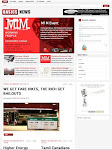by Herman Rosenfeld - BASICS #14 (June / July 2009)
In the past couple of months, there have been important changes to the auto sector in Canada and the US. In the midst of the ongoing economic crisis, started by the financial meltdown, auto sales dropped through the floor.
The restructuring of GM and Chrysler was engineered by the U.S. state. Its goal was to transform them into competitors with the Japanese-owned transplants (Honda and Toyota), lean and mean profit-making machines with weak (or no) unions, in the spirit of neoliberalism. A key element of the new situation is the historic defeat of the auto unions (the American UAW and the Canadian CAW), signaling a further decline in the living and working conditions of the working class as a whole.
The Obama administration started a process of “structured” bankruptcies in order to drive the restructuring of Chrysler and GM. This raised a bigger political issue of the legitimacy, role and purpose of state aid to the auto corporations.
The Obama administration in the U.S. provided a process for the possible longer-term survival of these companies in a hyper-competitive market, including the selection of a group of Wall Street-based financial types to oversee the corporations’ transformation; pressure on bondholders (owners of GM and Chrysler debt) to reduce their claims; attacks on the rights of workers (by demanding massive wage and benefit concessions); and requirements that each of these corporations close plants, layoff workers and reorganize themselves so as to dramatically reduce costs. By appealing to the public in defense of “taxpayers’” money, and by calling on all “stakeholders” to engage in common sacrifice, U.S. and Canadian leaders appear as reasonable stewards of public resources.
In limiting the claims of the bondholders, the Obama administration acted in the interests of the entire U.S. bourgeois class. The attack on the unions was the centerpiece of the strategy. Most important, Obama, Harper and McGuinty all demanded that the unions match the cost structure of the non-union transplants. This was accepted without question by both the UAW and CAW. It signaled a massive give-back of incomes, working conditions, time off and benefits. During the entire process of restructuring, there was no union-organized resistance, other than a series of CAW demonstrations demanding protection of retiree pensions.
These attacks have crippled both unions and dramatically reduced their credibility. The UAW is now the custodian of a significant chunk of GM stock – but it can only be used to pay for the health care benefits of retirees. The CAW has little independence from its auto employers and has lost any claims to be a fighting union.
The role of the state in both the U.S. and Canada is also a matter of some controversy. The huge loans that these governments have given - and will continue to give to the companies - have been translated into share ownership in the latter. On paper, the U.S. government owns 60% and the Canadian governments will own 12.5% of GM.
Hard right-wing political and economic interests in Canada and the U.S.(Republicans and right-wing Tories) denounced this as “buying jobs” and contributing to future government deficits. Mainstream politicians defend the aid as necessary to protect against massive job loss. Industrial relations enthusiasts are excited about “worker ownership and participation.”
Socialists look at the situation differently. Just because the U.S. and Canadian states own stock in GM and Chrysler, doesn’t mean that they have effectively “nationalized” them. In fact, government stock ownership in this instance is nothing more than a way of leveraging the loans and temporarily enforcing the rules of the neo-liberal marketplace, until and if (and there is no guarantee) these corporations are able to operate on their own. Obama and others have said so.
And, in another sense, it couldn’t really be otherwise, given the nature of the capitalist state and the politicians who control it today. They are committed to the operation of such a marketplace and do not have – and do not want – the capacity to run a company, let alone an entire economic sector. Owning one company could never transform the sector, anyway. What’s needed is to regulate the amount of autos being produced and social ownership of the entire sector, including all of the assemblers, parts producers, energy resources and mass transit. Perhaps the nationalization of the parts sector – a central repository of productive capacity – would be a good start.


.jpg)





